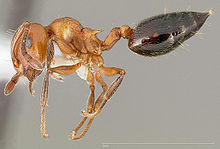| Crematogaster Temporal range: Eocene-present,
| |
|---|---|

| |
| C. hespera worker | |
| Scientific classification | |
| Domain: | Eukaryota |
| Kingdom: | Animalia |
| Phylum: | Arthropoda |
| Class: | Insecta |
| Order: | Hymenoptera |
| Family: | Formicidae |
| Subfamily: | Myrmicinae |
| Tribe: | Crematogastrini |
| Genus: | Crematogaster Lund, 1831 [1] |
| Diversity | |
| > 420 species | |


Crematogaster is an ecologically diverse genus of ants found worldwide, which are characterised by a distinctive heart-shaped gaster (abdomen), which gives them one of their common names, the Saint Valentine ant.[2] Members of this genus are also known as cocktail ants because of their habit of raising their abdomens when alarmed.[3] Most species are arboreal (tree-dwelling). These ants are sometimes known as acrobat ants.[4]
Cocktail ants acquire food largely through predation on other insects, such as wasps.[5] They use venom to stun their prey and a complex trail-laying process to lead comrades to food sources. Like most ants, Crematogaster species reproduce by partaking in nuptial flights, where the queen acquires the sperm used to fertilize every egg throughout her life.[citation needed]
- ^ "Crematogaster". Integrated Taxonomic Information System.
- ^ Alex Wild (2007-07-21). "Crematogaster". Archived from the original on 2007-08-06.
- ^ African Insect Life - S. H. Skaife (Longmans, Green — Cape Town)
- ^ Acrobat Ant, Iowa State Univ., Dept. of Entomology
- ^ Schatz, Bertrand, and Martine Hossaert-Mckey. "Interactions of the Ant Crematogaster Scutellaris with the Fig/fig Wasp Mutualism." Ecological Entomology 28.3 (2003): 359-68. Print.